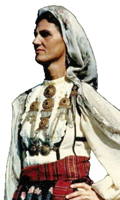
|
The Society of Folk Dance Historians (SFDH) Vilma Matchette
[
Home |
About |
Encyclopedia | CLICK AN IMAGE TO ENLARGE |

|
BACKGROUND
Information: Vilma Matchette, teacher of Armenian, Greek, Lebanese, Balkan, and international dance.
Vilma Matchette was born Vilma Lenshaw in San Francisco, California, and was active as a dancer with her brother Ernest as her partner beginning in 1939 and as a folk dance teacher and director beginning in 1945.
In 1948, she and her husband, George Matchette, met John Filcich of Festival Records fame, and became part of John's dance group, the Yugoslav Folk Dancers, performing at various venues for ethnic groups. The Matchette's son and daughter, René and Dana, were folk dancing at an early age.
Vilma was well versed in international folk dancing but was primarily interested in Balkan and Greek dance. She and her mother were on the committee for the first San Francisco Kolo Festival in San Francisco. Vilma quickly became an expert on Balkan costumes and had collections of dolls, records, and costumes from all over the world.
She taught Balkan Dance and Culture at Portrero Hill Center in San Francisco from 1957 to 1959 and was a director, teacher, and coordinator of the Bay Area Byzantine Chorale (a Greek Folk Dance and Song Group) from August 1961 to September 1965. In the fall of 1965, Vilma taught Greek Folklore and Dance at the University of California, Berkeley Extension.
In 1968, Vilma moved to Los Angeles and became even more involved in costumes, becoming the dressmaker for the AMAN Folk Ensemble, AVAZ International Dance Theatre, and several Greek dance groups. She taught Greek Dance and Culture at the University of California at Los Angeles (UCLA Extension), worked for the UCLA Ethnic Collections Department, and for years was a judge for the Greek Orthodox Folk Dance Festival. She also taught at the Santa Barbara Folk Dance Conference.
Vilma and Dick Oakes contributed to a show titled "A Decade in Retrospect" for The UCLA Museum of Cultural History in Los Angeles at the Frederick S. Wright Art Gallery, where works from Asia, Europe, The Near East, Africa, North and South America, and Indonesia and Oceania were drawn mostly from museum collections.
Vilma taught special classes in Armenian dance at the famed Intersection Folk Arts Center in Los Angeles, the California Kolo Festival, and other workshop venues and folk dance camps.
Vilma had extensive museum experience in folk art as a lecturer, project coordinator, decorative arts specialist, and exhibitor. She also was on the staff of Sotheby's, specializing in folk art, especially textiles. Her museum experience in Folk Art includes:
- Folk Art Around the World, Spring 1967 at UCLA; "A Survey of Folk Costume Around the World" and "Mediterranean Folk Arts" (Greece, Folk Costume). Lecturer.
- Ethnic Collections, UCLA Fall of 1965 to 1969. Folk Art in Context (a special project) Spring 1969. the Balkans: Costume and Folk Art (a gallery showing), Fall, 1969.
- Los Angeles County Museum of Art, Costume Department. Fall 1965 to Spring 1966.
- De Young Memorial Museum, San Francisco, Decorative Arts Department, under the curator Mr. G. Keith, Spring 1960 to Fall 1965.
- California Historical Society, San Francisco, in the Art Department under Dr. Joseph Baird, Curator, 1961 to 1964.
- "A Decade in Retrospect," UCLA Museum of Culture and History, Los Angeles.
Vilma passed away in November, 2000. A few years before her death, she had moved to Seattle, Washington, and used her years of work and research to write a book on dolls around the world.
Vilma's articles and publications include
- World Colors Dolls & Dress. 192pp. with Susan Hedrick, Hobby House Press, Inc., Grantsville, Maryland, 1997.
Dances Vilma taught include Bar, Dabke Ba'albakia, Debki Hawara, Debki Zaroura, Epirotiko, Fissouni (Fysouni), Gaida, Haleh (Halay), Hasapikos, Karsi Bar, Karsilamas, Kastorianos, Kerkyreikos, Khiotiko Syrto, Kritikos Syrtos, Laz Bar, Lefkaditikos, Menousis, New Bar, Pentozalis, Pompouri, Tamzara, Trata, Trava Trava, Tsakonikos, Turkish Halay, Vari Hasapiko, Veliko Kolo, and Zeybek.
This page © 2018 by Ron Houston.
Please do not copy any part of this page without including this copyright notice.
Please do not copy small portions out of context.
Please do not copy large portions without permission from Ron Houston.